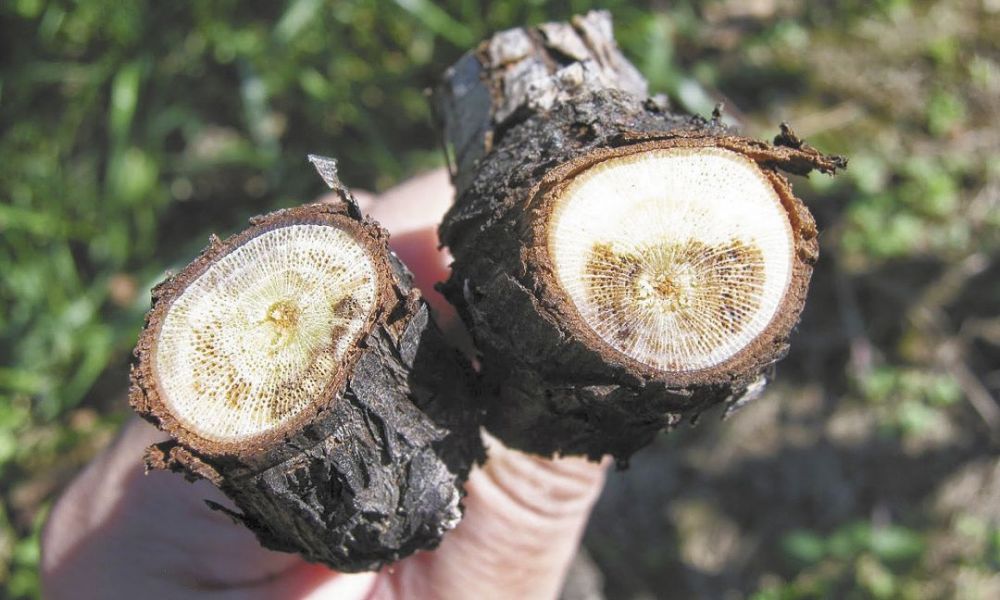The Big Cut
Trunk disease affects pruning and vineyard longevity
Pruning should be done to promote a fruitful year and also to maintain the health and longevity of the vines. As many of Oregon’s vineyard reach 10 years and older, how the vines are pruned impacts the vine’s health. Each year, pruning is done during the winter months when around 90 percent of last season’s growth is removed. There are a number of goals of pruning that include maintaining the desired structure and head height of the vine, balancing vegetative growth with fruit production and pruning to establish good pruning positions for future years.
Pruning a vine creates a wound. As the wound heals, it can leave dead wood that does not produce latent buds or can become infected with diseases. In the Willamette Valley, if the vines are pruned early in the winter, many cool, rainy days follow where rain can splash disease spores into the open wounds. This can lead to trunk cankers and sometimes death after several years.
With new research on trunk diseases, there appears to be multiple pathogenic fungal species, and, sometimes, these will be identified in complexes. Some trunk diseases such as Young Vine Decline (Phaacremonium species) can be present in plant material originating from nurseries. However, here we will discuss Eutypa Dieback (Eutypa and other fungi) and Bot canker (Botryosphaeria species) and their potential impact on the productive longevity of vineyards and methods to help prevent infections.
Where do these spores come from and how do they spread? The spores can come from infected vines but also from other host plants which could be growing around vineyards. There are at least 90 known host plants. The spores are splashed by rain from one vine to another but they also travel in wind currents and move to 30 to 60 miles.
Once the spore lands on the vine’s open wound, it starts growing into the wood. Eutypa develops more slowly and might only move 1 to 2 inches into the wood during the winter. Bot canker can grow more quickly. They both cause wedge-shaped cankers in the wood. The canker will continue to move deeper into the trunk over several years, eventually killing the vine, if it not identified and pruned out.
Symptoms are different between these two trunk pathogens. In the spring, it is important to survey the vineyards for indications in the new shoot growth. Eutypa will have distinctive growth that is easiest to detect in shoots 12 to 24 inches in length. The growth will be spindly, weak and have yellowish leaves. Bot canker does not have this type of growth. Instead, the cane or spurs could be dead with little or no growth. Once identified, the vines should be flagged so they can be pruned 6 inches below the canker.
Grapevine pruning wounds are susceptible to infection by trunk diseases for as long as seven weeks. The length of this period varies with temperature, time of pruning, size of the wound, and age of the wood pruned. As vines get older, more large pruning wounds occur as pruning crews work to keep the heads at the right height, around a hand’s distance below the fruit wire.
In California, spore releases were detected with the start of fall rains, continuing through the winter months with fewer releases in February and basically none in March.
In Oregon, crews often start pruning in December and continue through the first half of March. Vineyards that are pruned early are at higher risk of exposure to trunk disease spores due to more rain events and spore releases and also a longer time period needed to heal the wounds because of cold temperatures.
To help promote the longevity and productiveness of vineyards, preventative strategies that are implemented in the vineyard — when it is less than five years old — help reduce the chance of infections. Careful monitoring in the spring helps detect problems early when they are still treatable with pruning out the diseased wood.
To reduce the chance of infections, vines should be pruned as late as possible, pruned during sunny weather and the wounds treated with a protective paint or paste. There are several different options for trunk treatments and the effectiveness varies due to Oregon’s numerous rain events. Biologicals such as Vitiseal work but are washed off by rain so multiple treatments are needed. Tree paints that are water resistant are more effective in providing protection for a longer period of time without needing retreatment.
If the vineyard does have infected vines, these vines need to be pruned below the canker, and the diseased wood removed and burned. In some cases, it might be beneficial to leave the big cuts until shortly before bud break in order to prune when the weather is warmer, fewer spore releases are occurring and the wound will heal faster. However, this means making another pruning pass through the vineyard.
There are some sources that recommend removing all pruning wood from the rows and burning it but others don’t think it is that important in terms of risk. Removing all the wood that was pruned is labor intensive and difficult. The one-year-old canes that were pruned off are not as likely to have overwintering spores on them as older wood that was removed; they can be flailed to break up and disrupt any disease formation.
There is often a question about sanitizing tools between pruning vines. For these types of trunk diseases, sterilizing equipment is unlikely to have much impact as it is the spore landing on and growing into the wound that is the start of the infection. However, it is good practice to prune vines with trunk diseases last to minimize spread to other vines.
In summary, trunk diseases such as Eutypa and Bot canker can have significant impacts on the health, productivity, longevity and cost of production as vineyard blocks age. Labor costs can increase due to trunk treatments, pruning and removal of diseased wood. Preventative treatments can help extend the productive life of vineyard. Let’s think twice about making “big cuts” while pruning.
Want to learn more? Visit these sites:
plant-clinic.bpp.oregonstate.edu
www.treeandvinetrunkdiseases.org
www.practicalwinery.com



 Jessica Cortell received an M.S. degree in horticulture and a Ph.D in food science and technology from OSU. She owns Vitis Terra Vineyard Services and teaches at the Northwest Viticulture Center in Salem.
Jessica Cortell received an M.S. degree in horticulture and a Ph.D in food science and technology from OSU. She owns Vitis Terra Vineyard Services and teaches at the Northwest Viticulture Center in Salem.









